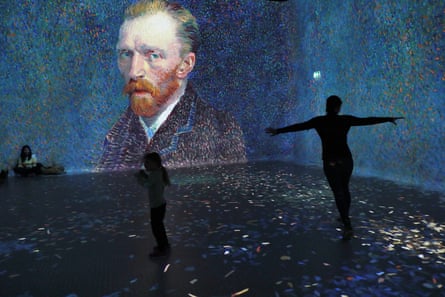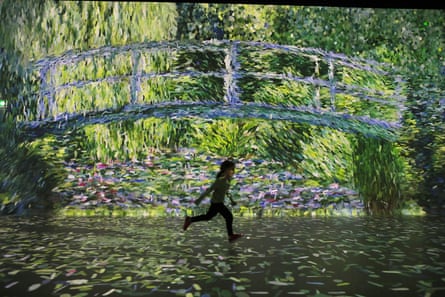Ready to dive in? The Rise and Rise of Immersive Art | Art
Conce I’m submerged, a shower is as far as I’m usually willing to go. I don’t acknowledge the existence of bathtubs and when it comes to immersive art, I prefer to be an engaged and critically alert observer, not a participant. I made an exception for Nicholas Hytner’s Shakespeare productions at the Bridge Theater in London, although I chose to watch the scrum – with the rest of the audience as a hearty, bickering mob in Julius Caesar or a bunch of enchanted in A Midsummer Night’s Dream – from the safety of a fixed seat. I love hearing the soprano at the end of Wagner’s Tristan und Isolde sing about ecstatically drowning in the currents of sound that flow from her, which she calls “the wafting universe of the world-breath”. In the opera house you can feel this sensorium beating around you, but it is only echoing air, and your head, like the singer’s, remains above the merely symbolic water.
The immersion promised by a variety of art exhibitions across London is also a harmless metaphor: at worst, you are overwhelmed by light. Even so, there is something alluringly mystical about these shows, now so popular that they have become a cult. Experienced in this way, paintings no longer exist to be viewed from an analytical distance and judged in formal terms; their purpose is to provide sensation and alter consciousness. The free-standing artwork disappears as we merge with it, merge into an explosion of color or become submerged by images that fall off the walls, spill onto the floor, and wash us away.
At Frameless, near Marble Arch, a million lumens bombard you with more than 479m pixels, while 158 speakers saturate you with music; the effect is a soft psychedelia, weakening the upright posture of Georges Seurat’s picnickers along the Seine and tempting you to join the sinners enjoying kinky pleasures in Hieronymus Bosch’s Garden of Earthly Delights. On one wall, the skull-like face from Edvard Munch’s The Scream makes a brief menacing appearance. Elsewhere, the pixels form themselves into the wild-eyed, red-bearded face of Vincent van Gogh, the prophet of sunlight at its sharpest. Van Gogh has his own immersive extravagance in stables off Spitalfields Market in east London, with galaxies spinning in the rooms and overgrown sunflowers unfurling jungle-like tendrils. In a converted boiler house on nearby Brick Lane, Dalí: Cybernetics sends you through a digital portal into a metaverse, where the surrealist’s twisted images spring to three-dimensional life and invade your head. Clocks melt, a tiger pounces on you while blowing a smaller tiger from its snarling mouth, and the eyes that Salvador Dalí painted on drapery for a nightmare scene in Alfred Hitchcock’s Spellbound fly through the air like squashy grenades.
David Hockney’s riveting autobiographical tour, which opens at Lightroom in King’s Cross in February, looks to be more aquatic, with hedonistic dips in backyard pools and springtime in the Normandy countryside seen through a curtain of torrential rain. Visitors will be passengers on one of the audio-visual “Wagner rides” he used to take through the San Gabriel Mountains of southern California, with local vistas of barren canyons and wooded rifts set to a soundtrack of orchestral tours of Wagner’s operas, arranged by Hockney to match the sun’s retreat from the mountain peaks. For Wagner, immersion is a spiritual and sensual drama – Senta in The Flying Dutchman plunges into the boiling sea only to rise again, instantly cleansed and redeemed, and in Tristan und Isolde desire ebbs and flows like blood like blood – or else blow it in a career of conquest, as when Siegfried swings his sword in Götterdämmerung and takes on the Rhine. Placed on these murky rituals, Hockney’s car ride will flee along highways to end at the beach as the sun makes its final dip into the sea.

Hockney’s title is Bigger & Closer (not smaller and farther away), which sums up the spatial appeal of exhibitions like his. In the Louvre, the Mona Lisa appears small and very far behind guardrails and a protective shield of glass; with luck, you watch her for a moment over someone else’s shoulder, before being pushed aside. Your consolation is to take a selfie and reduce the once sacred image to a backdrop for your own triumphant visage. Immersive shows recognize this state of affairs and do away with the standalone artwork altogether as you are projected through the frame to swim in a painting that stretches to accommodate you. The picture now looks outdated because it is boringly static; what matters is a cinematic liberation of the eye. In an age when movies can be printed on the screens of our electronic devices, here is a new way to lose ourselves again in the amplitude of what Terry Gilliam called an “imaginarium” – the playground of someone else’s fantasy .
At least my own first experience of immersion took place in a watery environment, not an empty hangar or a disused factory. In Lisbon, an aqueduct designed in the 18th century to bring water to the thirsty city crosses valleys and ends on a hilltop in a massive indoor reservoir known as the Mãe d’Água, or Mother of the Waters:’ a womb cave, with tanks whose slurping contents reverberate under a vaulted roof held up by pointed pillars. Here, on a rippling jetty jutting out into one of the pools, I watched the work of Claude Monet and Gustav Klimt liquefy on the walls and drip into the dark tanks. The experience had little to do with the images that rained down on me and trickled away from under my feet; dissolved into vague impressions, the paintings became drugs designed to induce moods – first of mournful calm, then of something more like nervous dread.

Monet had his own lily ponds at Giverny, so his images felt at home here, with watery flowers climbing out of the tanks and winding around the columns. The musical accompaniment began, strangely enough, with a call from Beethoven’s Fifth Symphony, but soon sank underwater to quote the watered-down sounds of a piano prelude by Debussy that evokes the Breton legend of a drowned cathedral, with muffled bells and priests chanting far below the surface. . A gold and purple montage from Monet’s views of Venice carried by the water also emerged from the shadows, then established, as the city itself would eventually do. The experience was lively, floaty, like drifting half-awake through the world on a promenade guided by the bold figure of Monet himself.
Archie Bland and Nimo Omer take you through the top stories and what they mean, free every weekday morning
Privacy Notice: Newsletters may contain information about charities, online advertising and content funded by outside parties. For more information see our Privacy Policy. We use Google reCaptcha to protect our website and Google’s Privacy Policy and Terms of Service apply.
With Klimt, seen smiling vaguely in a monk’s robe, the dream turned morbid. Lying women of his portraits, fast asleep in the night sky, looked like malevolent zeppelins as they glided between the arches; one of them left a pair of disembodied feet twitching in a corner as if stirred by a nightmare. A cave above one of the tanks suddenly bled red, ready to function as the altar in a devil’s sabbath. It all ended with a downpour from the center of the ceiling, where flecks of orange and burnt ocher peeling from Klimt’s decor sharply converged and collided: the sky seemed to fall in and was immediately engulfed by the black water swallowed the tanks. The quiet gloom as the images faded was that of a bunker, defenseless against combustion in the upper air and a flood tide rising from below.
Immersive shows are out-of-body experiences; they entice us to shed our skins and give up our separate identities
As the planks of the jetty swayed beneath me, I remembered a commandment from Joseph Conrad’s novel Lord Jim, where someone explains the hero’s suicidal folly by saying that we must all “immerse in the destructive element”. Jim jumps overboard when his ship founders and is haunted by the memory of his cowardice; his apologist says that he had no choice, for “a man who is born falls into a dream” as if into the sea, and will drown if he tries to pull himself out—our only hope is to avoid the destructive element and rely on the waves to support us. Is that what we’re testing when we dive into those ocean images? Immersive shows are out-of-body experiences; they entice us to shed our skins, give up our separate identities and become empty vessels for the flood of pixels.
Their multicolored flood might also invite us to preview the way the world might end. Outside the aqueduct, I noticed a sign announcing a catastrophic immersive experience elsewhere in the city: a multisensory re-enactment of the 1755 earthquake that toppled the buildings on Lisbon’s seven hallowed hills, the debris engulfed by ‘ a tsunami and a sudden stop to the optimism of the Enlightenment. “Are you ready to participate?” asked the poster. Not today, I thought, but maybe soon. It is surely not too early to rehearse the coming apocalypse, which is sure to be a spectacular show.
About ARTMUSEM
We promise to tell you the important news in the field of art.
source https://artmusem.com/cbmiewh0dhbzoi8vd3d3lnrozwd1yxjkawfulmnvbs9hcnrhbmrkzxnpz24vmjaymy9qyw4vmjgvaw1tzxjzaxzllwfydc1leghpyml0aw9ucy1wb3b1bgfylwrhdmlklwhvy2tuzxktdmfulwdvz2gtzgfsas1sb25kb27saqaoc5/
Comments
Post a Comment